SDTEST® has 38 different VUCA polls that calculate the 13,643 correlation values between stages of development according to the theory of Spiral Dynamics and answer options of these 38 polls.
We invite curiosity about the systemic mechanisms behind this correlation. There may be hidden variables that provide alternative explanations.
In our analysis of the poll "What makes people successful at work?" we found an intriguing positive linear correlation that warrants closer examination:
0.0150 (Pearson) between the Honesty and the Purple stage.
The critical value of the correlation coefficient for a non-normal distribution, by Spearman, is r = 0.0015. Nevertheless, this positive linear correlation of 0.0150 meets the reliability criteria but does not necessarily imply causation.
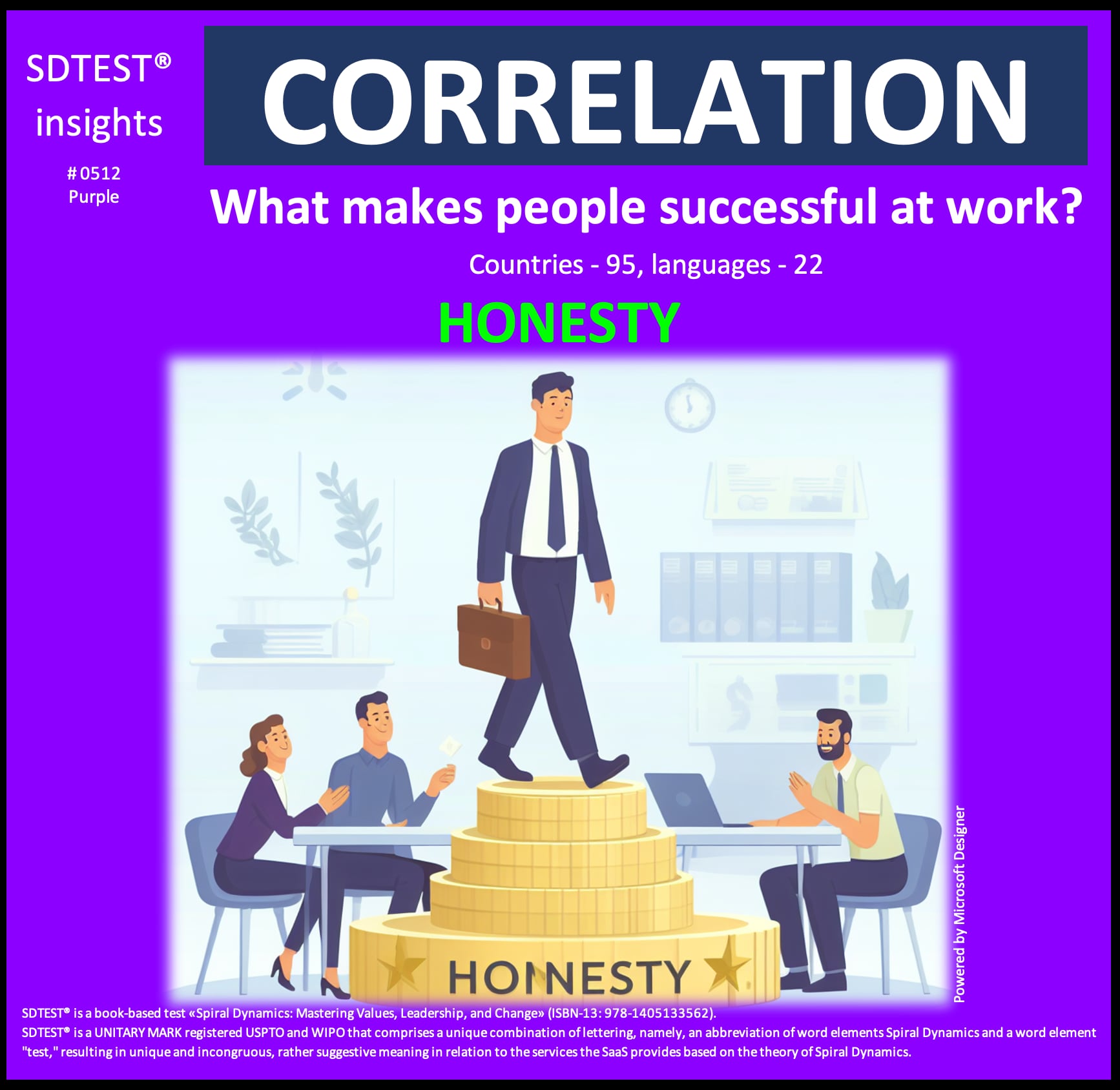
This positive correlation of 0.0150 between "Honesty" as a factor for work success and the Purple stage offers intriguing insights when viewed through the lens of the Purple value system:
Organizational Perspective:
Organizations operating within the Purple mindset might interpret this correlation as:
- Validation of their tradition-based approach, where ancestral values of truthfulness are fundamental to organizational harmony.
- Confirmation that their ritual-guided systems naturally reward those who honor the sacred trust within the community.
- Evidence supporting their belief that spiritual integrity and honesty create the foundation for collective prosperity.
These organizations might respond by:
- Reinforcing ceremonial practices that celebrate and acknowledge honest behavior within the workplace.
- Implementing recognition systems that honor those who demonstrate truthfulness as a sacred duty to the group.
- Promoting leaders who embody the ancestral wisdom of honesty as a cornerstone of community well-being.
Team Perspective:
Teams operating from a Purple mindset might approach this correlation by:
- Viewing it as an affirmation of their understanding that honesty maintains the sacred bonds that hold the team together.
- Interpreting it as support for their belief that truthfulness protects the team from harmful spirits and misfortune.
- Seeing it as validation for prioritizing authentic relationships based on ancestral teachings about truthful communication.
These teams might respond by:
- Establishing rituals and practices that encourage open, honest sharing within the sacred circle of the team.
- Encouraging team members to speak truthfully as a way of honoring their ancestors and maintaining group harmony.
- Celebrating instances of honesty as demonstrations of spiritual strength and commitment to the collective good.
Individual Perspective:
Individuals aligned with the Purple value system might interpret this correlation as:
- Personal validation of their commitment to ancestral teachings about the power of truthful living.
- Evidence supporting their belief that honesty connects them to the spiritual forces that guide success.
- Confirmation of the value they place on maintaining their sacred identity through authentic expression.
These individuals might respond by:
- Deepening their practice of honesty as a spiritual discipline that honors their ancestors.
- Viewing truthfulness as a way of maintaining their connection to the divine forces that influence their work.
- Using honest communication as a means of preserving their sacred identity within the workplace community.
This correlation, viewed through the Purple lens, suggests that those operating at the Purple level understand honesty as a sacred principle essential for work success. It implies that the Purple value system's emphasis on tradition, spiritual connection, and ancestral wisdom aligns with a deep reverence for truthfulness as a foundational virtue.
The reasons why honesty might make people successful at work in the Purple stage could include:
- Sacred Trust: Honesty maintains the sacred bonds of trust that are essential for community survival and prosperity.
- Ancestral Wisdom: Truthfulness honors the teachings of ancestors who understood honesty as fundamental to group harmony.
- Spiritual Protection: Honest behavior protects individuals and the community from the spiritual consequences of deception.
- Ritual Integrity: Truthfulness maintains the authenticity required for effective participation in communal rituals and traditions.
- Divine Favor: Honest living aligns individuals with spiritual forces that bring success and abundance to the community.
This correlation prompts us to consider how different value systems influence perceptions of work success factors. It raises questions about the potential benefits of a Purple approach to workplace integrity, particularly in contexts where trust, community cohesion, and shared values are essential.
Ultimately, this correlation highlights the complex interplay between cultural values, spiritual beliefs, and workplace effectiveness. Honesty might be seen not merely as a practical virtue but as a sacred principle that connects work success to deeper spiritual and ancestral wisdom in Purple-dominant environments.
In our analysis of the poll "Are you ready to receive less pay to work remotely?" we found an intriguing positive linear correlation that warrants closer examination:
0.1198 (Pearson) between the I am not ready to receive less pay to work remotely and the Red stage.
The critical value of the correlation coefficient for a normal distribution, by William Sealy Gosset (Student), is r = 0.0593. Nevertheless, this positive linear correlation of 0.1198 meets the reliability criteria but does not necessarily imply causation.
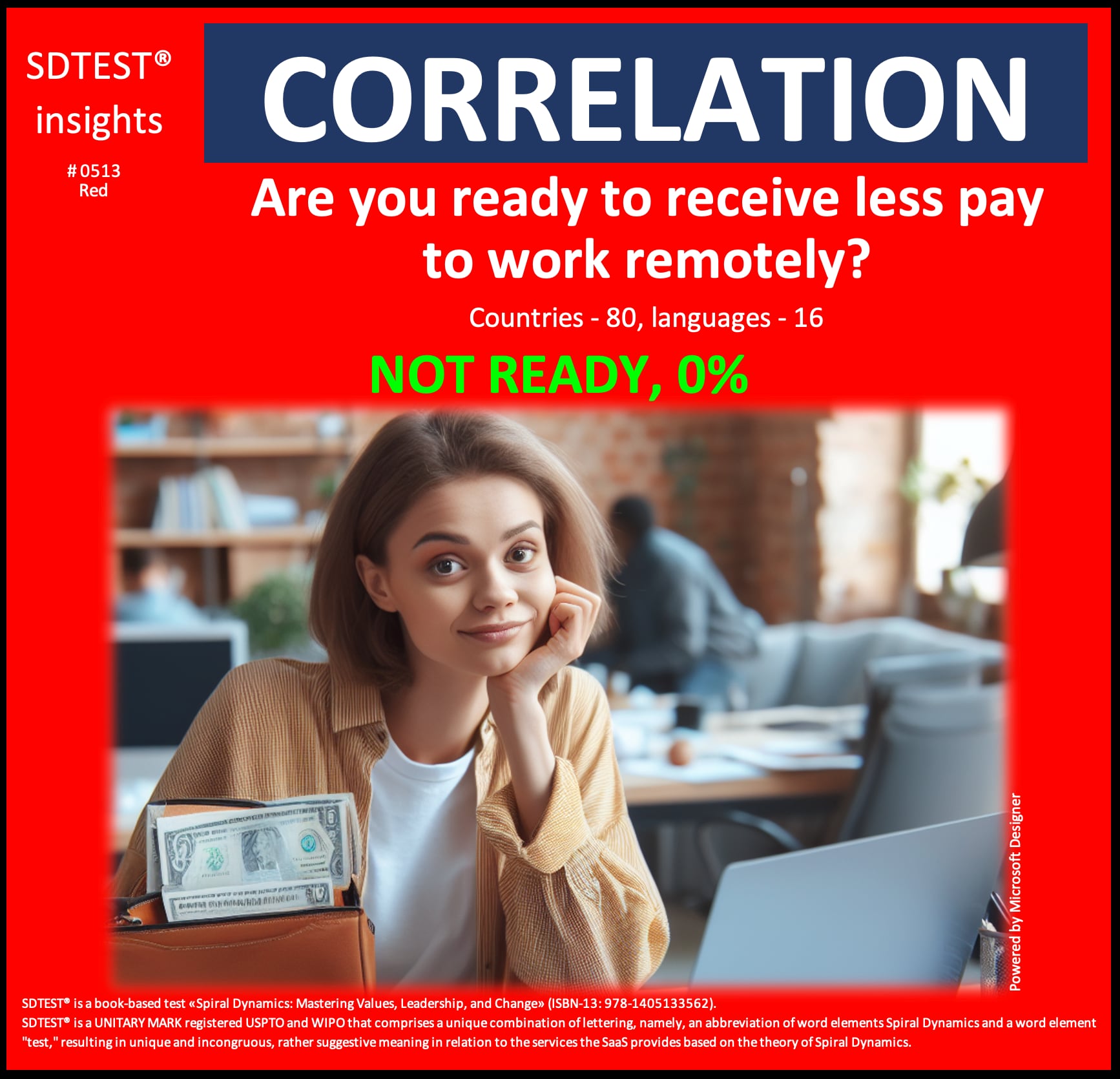
This positive correlation of 0.1198 between "I am not ready to receive less pay to work remotely" and the Red stage offers intriguing insights when viewed through the lens of the Red value system:
Organizational Perspective:
Organizations operating within the Red mindset might interpret this correlation as:
- Validation of their power-driven approach, where Reds dictate terms rather than accept organizational compromises on compensation.
- Confirmation that their warrior culture naturally attracts individuals who refuse to be controlled by others' conditions and instead impose their own.
- Evidence supporting their belief that true dominance means getting both full pay AND remote work flexibility when Reds decide they want it.
These organizations might respond by:
- Recognizing that Red leaders will demand remote work privileges without salary reductions, others may compromise, but not Reds.
- Implementing systems that acknowledge Reds will set their own work arrangements while maintaining maximum compensation.
- Understanding that Red employees view any pay-for-flexibility trade-off as a weakness - they expect to have both on their terms.
Team Perspective:
Teams operating from a Red mindset might approach this correlation by:
- Viewing it as affirmation that Reds in the team will dictate their own work conditions rather than accept management's trade-off proposals.
- Interpreting it as support for their belief that Reds don't make compromises - if they want remote work, they'll get it without sacrificing pay.
- Seeing it as validation that Red team members expect others to accommodate their demands, not the reverse.
These teams might respond by:
- Recognizing that Red team members will demand the best of both worlds - full compensation AND work flexibility when they choose it.
- Understanding that the Reds view any request for pay cuts as an attempt to dominate them, which they will aggressively resist.
- Accepting that Red individuals will negotiate from a position of demanding everything rather than accepting trade-offs.
Individual Perspective:
Individuals aligned with the Red value system might interpret this correlation as:
- Personal validation that they set the terms of their employment, not accept conditions imposed by others.
- Evidence supporting their belief that they deserve both maximum pay AND work flexibility - why should they choose one over the other?
- Confirmation that accepting pay cuts for any reason represents submission to authority, which goes against their core nature.
These individuals might respond by:
- Demanding remote work privileges while maintaining full salary because they believe they have the power to set such terms.
- Viewing any suggestion of pay-for-flexibility trade-offs as an insult to their dominance and personal worth.
- Using their refusal to compromise as a demonstration that they control their work conditions, not their employers.
This correlation, viewed through the Red lens, suggests that those operating at the Red level reject pay cuts for remote work because Reds set the conditions, not accept them. It implies that the Red value system's emphasis on power, dominance, and control means they expect to have both full compensation AND remote work flexibility when they decide they want it, with compromises expected from others, not themselves.
The reasons why people in the Red stage might not be ready to receive less pay to work remotely could include:
- Power Control: Reds dictate their own terms - if they want remote work, they'll get it without reducing their income because they set the conditions.
- Dual Dominance: The Red mindset refuses to choose between benefits - they demand both full pay AND remote flexibility because they believe they can have everything.
- Authority Rejection: Accepting pay cuts means submitting to someone else's terms, which fundamentally contradicts the Red need to be in control.
- Conditional Demands: Reds will work remotely when it serves their immediate desires, but only on their terms, with full compensation maintained.
- Power Positioning: If remote work becomes advantageous to Reds, they'll secure it while forcing others to make the financial compromises.
This correlation prompts us to consider how different value systems influence workplace power dynamics. It raises questions about how organizations manage Red employees who expect to set their own terms - demanding both maximum compensation AND work flexibility without compromise, while expecting others to accommodate their conditions.
Ultimately, this correlation highlights the complex interplay between power dynamics, compensation expectations, and work arrangement control. For Reds, remote work isn't about trading pay for flexibility - it's about having the power to demand both when it serves their interests, with any compromises falling on others, not themselves.
In our analysis of the poll "Oxford Happiness Survey," we found an intriguing positive linear correlation that warrants closer examination:
0.0514 (Pearson) between the I feel I have a great deal of energy / Strongly Agree and the Blue stage.
The critical value of the correlation coefficient for a normal distribution, by William Sealy Gosset (Student), is r = 0.0505. Nevertheless, this positive linear correlation of 0.0514 meets the reliability criteria but does not necessarily imply causation.
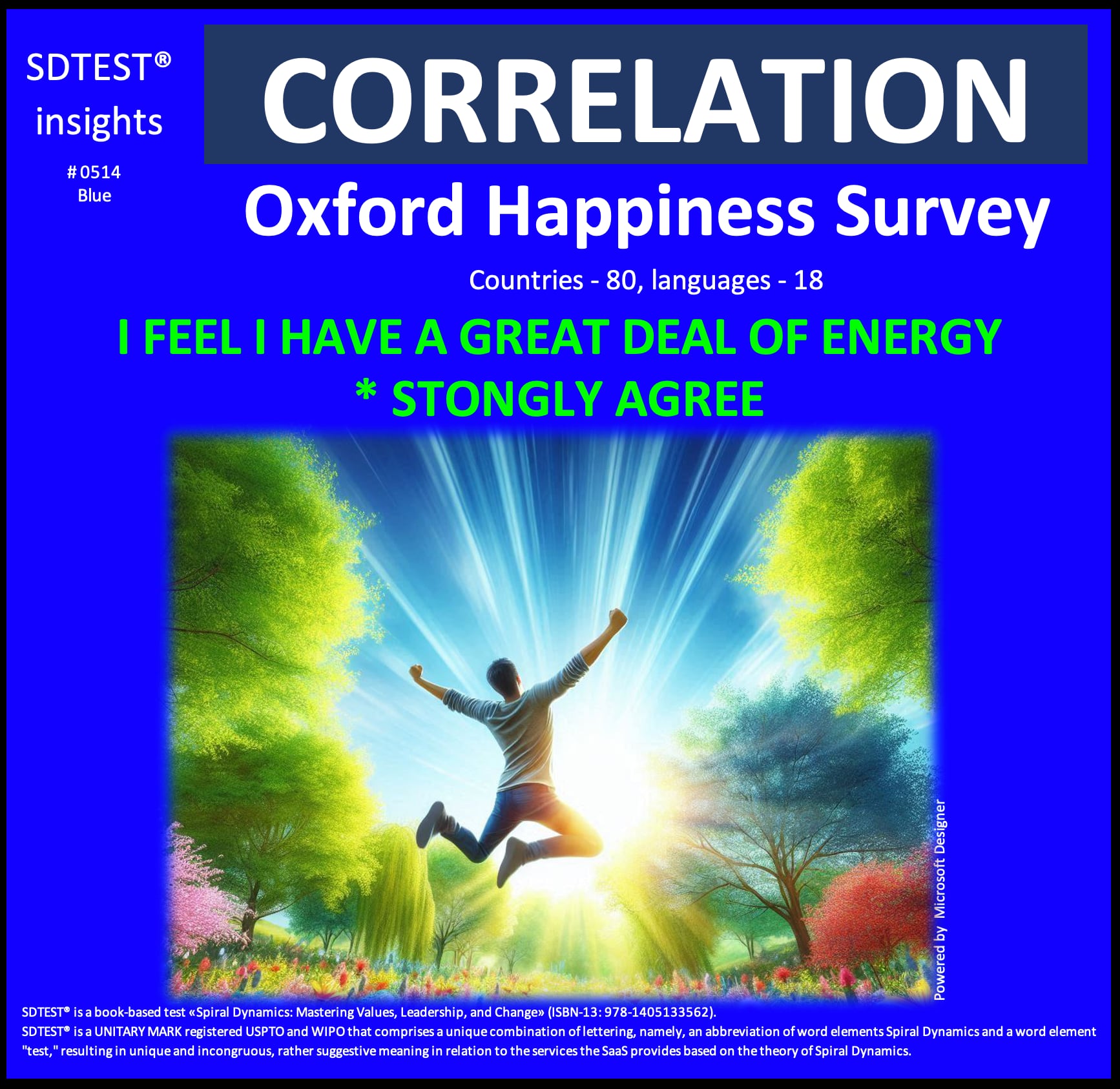
This positive correlation of 0.0514 between "I feel I have a great deal of energy / Strongly Agree" and the Blue stage offers compelling insights when viewed through the lens of the Blue value system:
Organizational Perspective:
Organizations operating within the Blue mindset might interpret this correlation as:
- Validation of their structured, hierarchical approach to creating energized and motivated workforces
- Confirmation that clear rules, procedures, and moral frameworks provide employees with purposeful energy
- Evidence supporting their belief that traditional organizational structures and established protocols generate sustainable vitality
These organizations might respond by:
- Reinforcing existing hierarchical structures and formal procedures that channel energy productively
- Implementing more comprehensive codes of conduct and ethical guidelines to provide moral clarity
- Strengthening traditional ceremonies, rituals, and institutional practices that energize through shared purpose
Team Perspective:
Teams operating from a Blue mindset might approach this correlation by:
- Viewing it as an affirmation of their disciplined, rule-based team structure
- Interpreting it as support for their belief that clear roles and responsibilities generate collective energy
- Seeing it as validation for prioritizing duty-driven collaboration over individualistic approaches
These teams might respond by:
- Establishing more detailed protocols and standard operating procedures to harness team energy
- Creating formal recognition systems that celebrate adherence to team values and moral codes
- Organizing regular team meetings focused on reaffirming shared principles and collective mission
Individual Perspective:
Individuals aligned with the Blue value system might interpret this correlation as:
- Personal validation of their disciplined approach to life and work
- Evidence supporting their belief that following established moral codes provides sustainable energy
- Confirmation that their sense of duty and responsibility generates personal vitality
These individuals might respond by:
- Deepening their commitment to established routines, traditions, and moral practices
- Seeking out more opportunities to serve higher purposes and fulfill their duties
- Strengthening their adherence to codes of conduct that provide structure and meaning
This correlation, viewed through the Blue lens, suggests that those operating at the Blue level may derive significant energy from structured, purposeful living. It implies that the Blue value system's emphasis on order, duty, and moral clarity aligns with sustained personal vitality.
The reasons why people might strongly agree they have great energy in the Blue stage could include:
- Purposeful Structure: Clear rules and hierarchies provide energizing direction and eliminate decision fatigue
- Moral Clarity: Strong ethical frameworks reduce internal conflict and channel energy toward righteous purposes
- Duty-Driven Motivation: A Sense of responsibility and service to higher authorities creates sustainable motivation
- Traditional Stability: Established routines and time-tested practices provide reliable energy sources
- Collective Identity: Strong group loyalty and shared values generate communal energy and support
This correlation prompts us to consider how structured value systems influence personal vitality and motivation. It raises questions about the energizing power of clear moral frameworks and traditional structures in providing a sustainable life force.
Ultimately, this correlation highlights the complex interplay between cultural values, personal energy, and life satisfaction. Energy might be seen not as chaotic enthusiasm but as disciplined vitality channeled through proper structures and moral purpose in Blue-dominant environments.
In our analysis of the poll "What makes a boss a great leader?" we found an intriguing negative linear correlation that warrants closer examination:
-0.0549 (Pearson) between the Trustworthiness and the Orange stage.
The critical value of the correlation coefficient for a normal distribution, by William Sealy Gosset (Student), is r = 0.0396. Nevertheless, this negative linear correlation of -0.0549 meets the reliability criteria but does not necessarily imply causation.

This negative correlation of -0.0549 between Trustworthiness as a leadership quality and the Orange stage offers intriguing insights when viewed through the lens of the Orange value system:
Organizational Perspective:
Organizations operating within the Orange mindset might interpret this correlation as:
- Validation of their performance-driven, results-oriented approach to leadership evaluation
- Confirmation that their merit-based, competitive culture prioritizes measurable outcomes over soft interpersonal qualities
- Evidence supporting their belief that technical competence and strategic thinking drive organizational success more than personal character traits
These organizations might respond by:
- Implementing more rigorous performance metrics and KPI-based leadership assessments that focus on quantifiable results
- Promoting leaders based on analytical capabilities, innovation potential, and strategic vision rather than relationship-building skills
- Developing leadership programs that emphasize data-driven decision-making and technological proficiency over trust-building exercises
Team Perspective:
Teams operating from an Orange mindset might approach this correlation by:
- Viewing it as an affirmation of their efficiency-focused, goal-oriented team dynamics
- Interpreting it as support for their belief that rational analysis and competitive excellence matter more than interpersonal reliability
- Seeing it as validation for prioritizing innovative problem-solving and individual achievement over collaborative trust-building
These teams might respond by:
- Establishing more sophisticated project management systems that track deliverables and performance rather than team cohesion metrics
- Encouraging team members to compete on merit and demonstrate expertise through measurable contributions
- Focusing team meetings on strategic planning, data analysis, and technological solutions rather than relationship maintenance
Individual Perspective:
Individuals aligned with the Orange value system might interpret this correlation as:
- Personal validation of their ambitious, achievement-oriented approach to leadership
- Evidence supporting their belief that competence and results speak louder than personal character
- Confirmation that their rational, analytical mindset is more valuable than emotional intelligence in leadership contexts
These individuals might respond by:
- Actively developing technical skills, strategic thinking abilities, and innovation capabilities rather than focusing on relationship-building
- Seeking leadership opportunities that showcase their analytical prowess and ability to drive measurable outcomes
- Using data-driven approaches to demonstrate their value rather than relying on personal connections or trust-based influence
This correlation, viewed through the Orange lens, suggests that those operating at the Orange level may prioritize competence-based leadership over character-based leadership. It implies that the Orange value system's emphasis on rationality, efficiency, and results aligns with a more pragmatic approach to leadership evaluation.
The reasons why Trustworthiness might not be seen as essential for great leadership in the Orange stage could include:
- Performance Priority: Results and measurable outcomes are viewed as more important indicators of leadership effectiveness than personal reliability
- Rational Decision-Making: Logical analysis and data-driven choices are valued over decisions based on personal relationships or emotional considerations
- Competitive Excellence: Individual achievement and innovative thinking are seen as more critical leadership qualities than interpersonal trustworthiness
- Efficiency Focus: Swift, strategic action based on objective analysis is prioritized over time-consuming trust-building processes
- Merit-Based Evaluation: Technical competence and proven track records are considered more reliable indicators of leadership potential than character assessments
This correlation prompts us to consider how different value systems influence perceptions of effective leadership. It raises questions about the trade-offs between relationship-based and performance-based leadership approaches, particularly in contexts where rapid innovation and competitive advantage are crucial.
Ultimately, this correlation highlights the complex interplay between cultural values, leadership expectations, and organizational effectiveness. Trustworthiness may be viewed not as a primary leadership requirement, but rather as a secondary consideration compared to demonstrable competence and results-driven performance in Orange-dominant environments.
In our analysis of the poll "Empathy is," we found an intriguing positive linear correlation that warrants closer examination:
0.0758 (Pearson) between the Sensing other people's emotions / Strongly Agree and the Green stage.
The critical value of the correlation coefficient for a normal distribution, by William Sealy Gosset (Student), is r = 0.0618. Nevertheless, this positive linear correlation of 0.0758 meets the reliability criteria but does not necessarily imply causation.
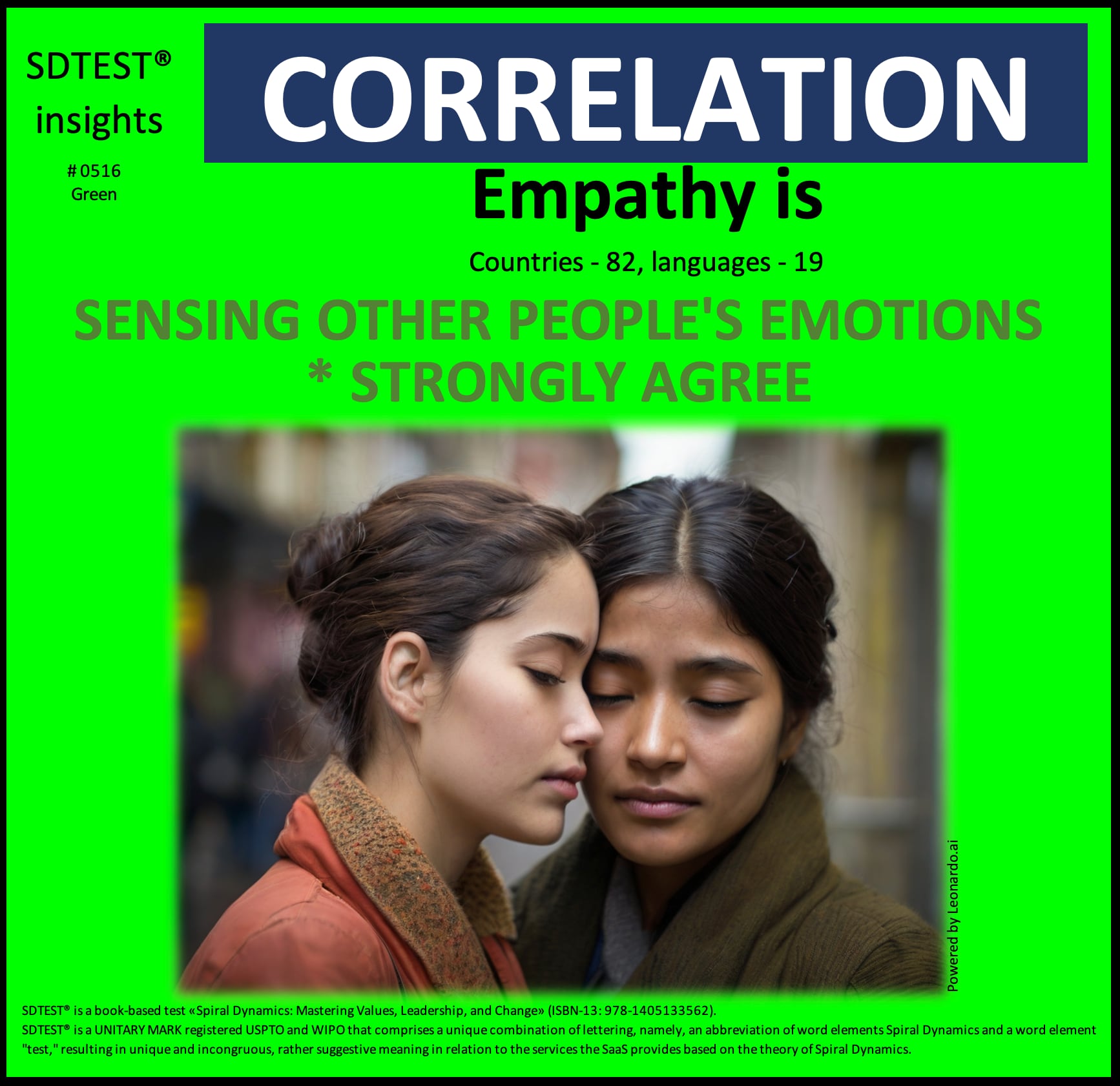
This positive correlation of 0.0758 between "Sensing other people's emotions / Strongly Agree" and the Green stage offers compelling insights when viewed through the lens of the Green value system:
Organizational Perspective:
Organizations operating within the Green mindset might interpret this correlation as:
- 1. Validation of their holistic, people-centered approach to organizational culture and emotional intelligence
- 2. Confirmation that their emphasis on psychological safety and inclusive environments fosters deeper human connection
- 3. Evidence supporting their belief that systemic well-being and collective emotional awareness drive sustainable organizational success
These organizations might respond by:
- - Implementing comprehensive emotional intelligence training programs and empathy-building workshops across all levels
- - Developing more sophisticated employee well-being systems that monitor and support emotional health holistically
- - Creating cross-functional collaboration spaces that prioritize emotional attunement and collective sensing in decision-making processes
Team Perspective:
Teams operating from a Green mindset might approach this correlation by:
- Viewing it as an affirmation of their collaborative, emotionally-aware team dynamics and collective consciousness
- Interpreting it as support for their belief that emotional sensing creates stronger team cohesion and shared understanding
- Seeing it as validation for prioritizing emotional integration and mutual support over task-focused efficiency
These teams might respond by:
- Establishing regular team practices focused on emotional check-ins, collective sensing, and empathetic dialogue
- Creating safe spaces for vulnerability and emotional expression that strengthen interpersonal bonds
- Implementing consensus-building processes that incorporate emotional intelligence and collective wisdom in team decisions
Individual Perspective:
Individuals aligned with the Green value system might interpret this correlation as:
- Personal validation of their emotionally intuitive, empathetically oriented approach to human relationships
- Evidence supporting their belief that emotional sensing is essential for authentic connection and collective well-being
- Confirmation that their holistic awareness and sensitivity to others' emotional states contribute to community harmony
These individuals might respond by:
- Deepening their mindfulness practices and emotional awareness techniques to enhance their empathetic capacities
- Seeking out opportunities for meaningful connection and emotional support within their communities
- Using their emotional sensing abilities to facilitate healing, understanding, and collective growth in their relationships
This correlation, viewed through the Green lens, suggests that those operating at the Green level may possess heightened emotional awareness and empathetic sensitivity. It implies that the Green value system's emphasis on interconnectedness, community well-being, and holistic understanding aligns with sophisticated emotional intelligence capabilities.
The reasons why people might strongly agree that empathy involves sensing other people's emotions in the Green stage could include:
- Systems Awareness: Understanding that individual emotions are interconnected within larger relational and ecological systems
- Collective Consciousness: Recognition that emotional sensing contributes to community harmony and shared well-being
- Holistic Integration: Viewing emotional intelligence as essential for authentic human connection and sustainable relationships
- Compassionate Action: Using emotional awareness as a foundation for caring, supportive responses to others' needs
- Unity Orientation: Seeing emotional sensing as a pathway to deeper understanding and connection across diverse perspectives
This correlation prompts us to consider how evolved value systems influence emotional intelligence and interpersonal awareness. It raises questions about the relationship between consciousness development and empathetic capacity, particularly in contexts where collective well-being and sustainable relationships are prioritized.
Ultimately, this correlation highlights the complex interplay between cultural values, emotional development, and community effectiveness. Empathy might be seen not as mere emotional recognition but as sophisticated sensing that enables authentic connection and collective flourishing in Green-dominant environments.
In our analysis of the poll "Ageism’s causes," we found an intriguing positive linear correlation that warrants closer examination:
0.1235 (Pearson) between the Yes, interpersonal interactions reflect broader social attitudes, and the Yellow stage.
The critical value of the correlation coefficient for a normal distribution, by William Sealy Gosset (Student), is r = 0.0826. Nevertheless, this positive linear correlation of 0.1235 meets the reliability criteria but does not necessarily imply causation.
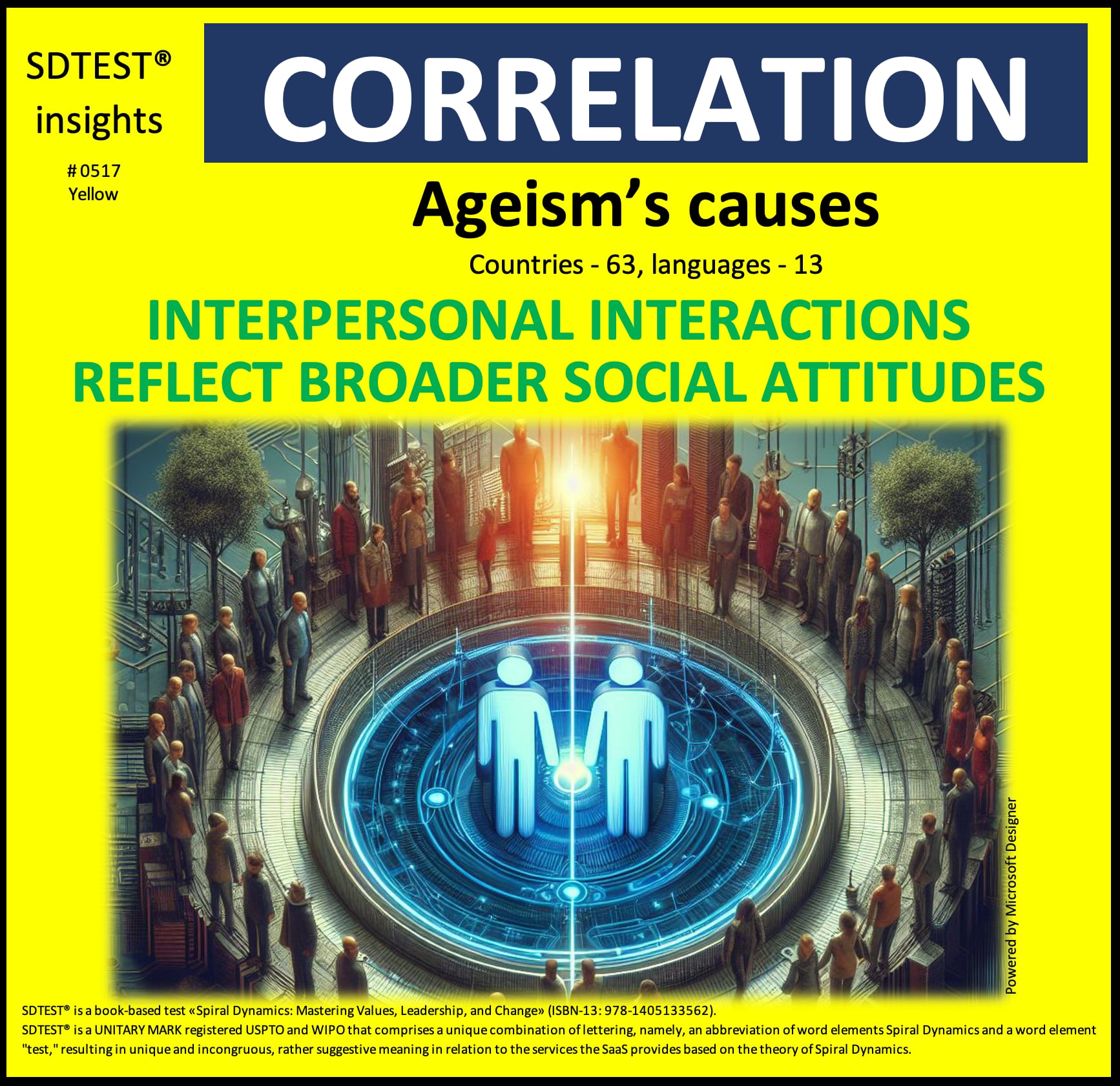
This positive correlation of 0.1235 between "Yes, interpersonal interactions reflect broader social attitudes" and the Yellow stage offers profound insights when viewed through the lens of the Yellow value system:
Organizational Perspective:
Organizations operating within the Yellow mindset might interpret this correlation as:
- Validation of their systems-thinking approach that recognizes interconnections between micro-interactions and macro-cultural patterns
- Confirmation that their integrative framework for understanding organizational dynamics captures the complex interplay between individual behaviors and societal structures
- Evidence supporting their belief that addressing systemic issues requires understanding how personal interactions both reflect and shape broader cultural attitudes
These organizations might respond by:
- Implementing comprehensive multi-level analysis systems that track patterns from individual interactions to organizational culture to societal impact
- Developing adaptive leadership programs that help executives understand how their interpersonal behaviors influence and are influenced by broader social systems
- Creating cross-sector partnerships and stakeholder engagement processes that address systemic issues like ageism through integrated approaches spanning multiple organizational levels
Team Perspective:
Teams operating from a Yellow mindset might approach this correlation by:
- Viewing it as an affirmation of their complex systems understanding that recognizes how team dynamics mirror and influence larger social patterns
- Interpreting it as support for their belief that effective team functioning requires awareness of how interpersonal patterns connect to broader cultural contexts
- Seeing it as validation for their integrative approach that addresses both immediate team interactions and systemic social influences
These teams might respond by:
- Establishing sophisticated reflection processes that examine how team interactions both reflect and challenge broader social attitudes and biases
- Creating learning frameworks that help team members understand their role in perpetuating or transforming systemic patterns like ageism
- Implementing adaptive practices that consciously work to model alternative interpersonal patterns that could influence broader social change
Individual Perspective:
Individuals aligned with the Yellow value system might interpret this correlation as:
- Personal validation of their complex perspective that sees connections between individual actions and systemic social patterns
- Evidence supporting their understanding that personal growth and social transformation are fundamentally interconnected processes
- Confirmation that their integrative awareness of multiple levels of reality enables them to recognize how interpersonal behaviors reflect broader cultural dynamics
These individuals might respond by:
- Deepening their self-awareness practices to understand how their own interpersonal patterns both reflect and influence broader social attitudes
- Engaging in conscious relationship practices that deliberately model alternative approaches to issues like ageism
- Using their systems understanding to facilitate dialogue and learning that bridges individual transformation with social change
This correlation, viewed through the Yellow lens, suggests that those operating at the Yellow level possess sophisticated awareness of the dynamic relationship between micro and macro social phenomena. It implies that the Yellow value system's emphasis on integration, multiple perspectives, and complex systems understanding enables recognition of how interpersonal interactions serve as both mirrors and engines of broader social attitudes.
The reasons why people might recognize that interpersonal interactions reflect broader social attitudes in the Yellow stage could include:
- Systems Integration: Understanding that individual, interpersonal, organizational, and societal levels are dynamically interconnected and mutually influential
- Multi-Perspective Awareness: Ability to simultaneously hold multiple viewpoints and see how different levels of social reality interact and influence each other
- Developmental Understanding: Recognition that social attitudes emerge through complex developmental processes that manifest across all levels of human interaction
- Pattern Recognition: Sophisticated ability to identify recurring patterns and their systemic implications across different scales of social organization
- Transcendent-Inclusive Thinking: Capacity to integrate insights from multiple value systems while understanding how social dynamics operate across different levels of complexity
This correlation prompts us to consider how advanced consciousness development influences understanding of social phenomena and systemic change. It raises questions about the relationship between individual awareness and collective transformation, particularly in addressing complex social issues like ageism that operate across multiple levels of human experience.
Ultimately, this correlation highlights the complex interplay between consciousness development, systems awareness, and social understanding. Interpersonal interactions might be seen not as isolated events but as dynamic expressions of broader cultural patterns that both reflect and shape social attitudes in Yellow-dominant environments.
0.1957 (Pearson) between the Job specialty - Management (product, project, etc) and the Turquoise stage.
The critical value of the correlation coefficient for a normal distribution, by William Sealy Gosset (Student), is r = 0.1763. Nevertheless, this positive linear correlation of 0.1957 meets the reliability criteria but does not necessarily imply causation.

This positive correlation of 0.1957 between "Job specialty - Management (product, project, etc)" and the Turquoise stage offers profound insights when viewed through the lens of the Turquoise value system:
Organizational Perspective:
Organizations operating within the Turquoise mindset might interpret this correlation as:
- Validation of their holistic approach that recognizes management roles as essential orchestrators of interconnected systems and sustainable value creation
- Confirmation that their ecological business model requires integrative leaders who can balance technological innovation with planetary well-being and social responsibility
- Evidence supporting their belief that complex, interdependent projects require management specialists who understand the intricate relationships between human systems, natural ecosystems, and technological solutions
These organizations might respond by:
- Implementing regenerative management frameworks that integrate product development with ecological stewardship and social impact measurement
- Developing cross-functional leadership roles that bridge technical expertise with systems thinking, sustainability principles, and stakeholder integration
- Creating management positions that specifically focus on harmonizing technological advancement with planetary health and collective well-being across all project lifecycles
Team Perspective:
Teams operating from a Turquoise mindset might approach this correlation by:
- Viewing it as an affirmation of their understanding that effective technology teams require integrative management that connects diverse perspectives and interdependent systems
- Interpreting it as support for their belief that product and project management serve as essential coordination points for balancing innovation with ecological and social consciousness
- Seeing it as validation for their collaborative approach that requires management specialists to weave together technical excellence, environmental sustainability, and human-centered design
These teams might respond by:
- Establishing management roles that specifically integrate technical delivery with sustainability metrics, stakeholder engagement, and long-term ecological impact
- Creating collaborative frameworks where management specialists facilitate dialogue between diverse team members, community stakeholders, and environmental considerations
- Implementing project management approaches that explicitly balance technological innovation with regenerative practices and collective flourishing
Individual Perspective:
Individuals aligned with the Turquoise value system might interpret this correlation as:
- Personal validation of their understanding that management roles in technology offer opportunities to integrate their holistic worldview with meaningful systems impact
- Evidence supporting their desire to work in positions that bridge technical capabilities with broader ecological and social transformation
- Confirmation that their integrative consciousness and systems awareness can be most effectively expressed through management roles that coordinate complex, interdependent initiatives
These individuals might respond by:
- Actively seeking management positions that allow them to integrate their technical skills with their commitment to planetary well-being and social justice
- Developing management competencies that specifically address the intersection of technology, ecology, and human flourishing
- Using management roles as platforms for modeling regenerative practices and facilitating collective consciousness within technological innovation
This correlation, viewed through the Turquoise lens, suggests that those operating at the Turquoise level may recognize management roles as essential integration points for complex, interconnected systems. It implies that the Turquoise value system's emphasis on holistic thinking, ecological awareness, and systemic integration aligns with appreciation for management positions that coordinate multiple dimensions of technological development.
The reasons why a Job specialty - Management might be essential for IT specialists in the Turquoise stage could include:
- Systems Integration: Management roles provide opportunities to coordinate complex, interdependent technological systems with ecological and social considerations
- Holistic Coordination: Product and project management positions enable integration of diverse perspectives, stakeholder needs, and sustainability requirements
- Conscious Leadership: Management specialists can model regenerative practices and facilitate collective consciousness within technological innovation processes
- Interconnected Impact: Management roles offer platforms for ensuring that technological development serves both human flourishing and planetary health
- Evolutionary Purpose: Management positions enable individuals to contribute to the conscious evolution of technology in the service of collective well-being and ecological harmony
This correlation prompts us to consider how advanced consciousness development influences career preferences and professional purpose. It raises questions about the relationship between individual awareness and systemic responsibility, particularly in roles that coordinate complex technological initiatives with broader ecological and social transformation.
Ultimately, this correlation highlights the complex interplay between consciousness development, professional choice, and systemic impact. Management specialties might be seen not as hierarchical positions but as essential integration points for conscious technological development that serves the interconnected web of life in Turquoise-dominant environments.
What insights do you gain from today's correlation? How might we study this relationship more carefully before deducing causation?
We welcome respectful and wise perspectives! Stay tuned every week as we share more results and insights.
After login or registration, free access to the poll results in the FAQ section.
2025.06.01
FearpersonqualitiesprojectorganizationalstructureRACIresponsibilitymatrixCritical ChainProject Managementfocus factorJiraempathyleadersbossGermanyChinaPolicyUkraineRussiawarvolatilityuncertaintycomplexityambiguityVUCArelocatejobproblemcountryreasongive upobjectivekeyresultmathematicalpsychologyMBTIHR metricsstandardDEIcorrelationriskscoringmodelGame TheoryPrisoner's Dilemma
Valerii Kosenko
Product Owner SaaS SDTEST®
Valerii was qualified as a social pedagogue-psychologist in 1993 and has since applied his knowledge in project management.
Valerii obtained a Master's degree and the project and program manager qualification in 2013. During his Master's program, he became familiar with Project Roadmap (GPM Deutsche Gesellschaft für Projektmanagement e. V.) and Spiral Dynamics.
Valerii is the author of exploring the uncertainty of the V.U.C.A. concept using Spiral Dynamics and mathematical statistics in psychology, and 38 international polls.








